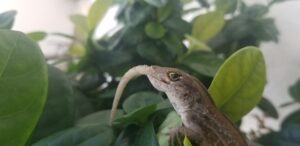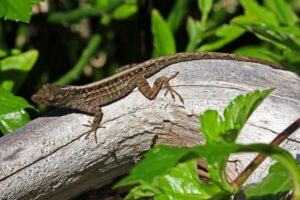
Brown Anole
Anolis sagrei
Report if seen anywhere on Maui

Known from and potential habitat
Species Info General
The brown anole is a wiley, carnivorous, and notoriously invasive lizard. Native to Cuba and the Bahamas, brown anoles are relative newcomers in Hawai‘i. O‘ahu residents first observed the brown anole in Lanikai in 1980. Brown anoles are now widely established across Maui, Kaua‘i, and Hawai‘i Island. They are commonly found in gardens and near resorts—typically in areas with lush plantings. You may recognize the brown anole for its vibrant orange or red dewlap (a flap of loose skin on its throat), which males display during courtship or when warding off other males. The brown anole will prey on anything from beetles and native insects to its own young.
The brown anole is widespread on Maui and beyone MISC’s resources to control. However, the State of Hawai‘i lists all species in the genus Anolis as Injurious Wildlife. It is prohibited to Release injurious wildlife into the wild; Transport them to islands or locations within the State where they are not already established and living in a wild state; Export any such species or the dead body or parts thereof, from the State.



Identification/Description
Brown anoles are typically between five and eight inches long. Males can weigh twice as much as females (8 grams vs 4 grams). Brown anoles have tan, grey, or brown coloration but can change color depending on stress, temperature, or environment. Males are usually darker than females. Brown anoles are also known for their bright dewlap, usually orange or red in color. Both males and females have dewlaps, but females don’t extend them as often. Males extend their dewlap when threatened or to attract a mate. Brown anoles are diurnal, which means they are active during the day.
Impacts
- Brown anoles are voracious carnivores. They primarily prey on insects and other invertebrates. In Hawai‘i, they may prey on native insects and land snails, potentially disrupting local ecosystems by reducing populations of these already vulnerable native species.
- While Hawai‘i lacks native land reptiles, the brown anole may compete with or, in some cases, eat other non-native lizard species, like the green anole, mourning gecko, and gold dust day gecko.
- Brown anoles can rapidly reproduce and often achieve high population densities in small areas. Their ever-increasing population makes them an easy food source for other invasive species in Hawai‘i, like cattle egrets. Brown anoles could be a substantial source of food for snakes if they ever become established in Hawai‘i.
- Efforts to control brown anole have been limited as no approved method for eradication exists. Brown anole is likely already too widespread for control efforts, making it a persistent ecological concern.
On Maui
East O‘ahu residents first observed brown anole in Lanikai in the 1980s. Today, they are widely established on O‘ahu, Maui, and Kaua‘i, and Hawai‘i Island. They colonized Hawai‘i Island as recently as 2011. Scientists studying brown anole’s movements around the islands suspect that they hitchhiked to Hawai‘i Island in ornamental plants from other islands.
Control info/Info on what MISC does about it
- Coming Soon!
Resources/References
- Reproduction in an Introduced Population of the Brown Anole, Anolis sagrei, from O’ahu, Hawai’i – University of Hawai‘i Press
- Brown Anoles on Hawai‘i and Battle of the Intercontinental Convergents – Anole Annals
- Brown Anole – Texas Invasive Species Institute
- Photo Attributions:
- Thomas Brown, CC BY 2.0 <https://creativecommons.org/licenses/by/2.0>, via Wikimedia Commons
- Nosferattus, CC0, via Wikimedia Commons
- (c) Chloe Brisco, some rights reserved (CC BY-SA), CC BY-SA 4.0 <https://creativecommons.org/licenses/by-sa/4.0>, via Wikimedia Commons
